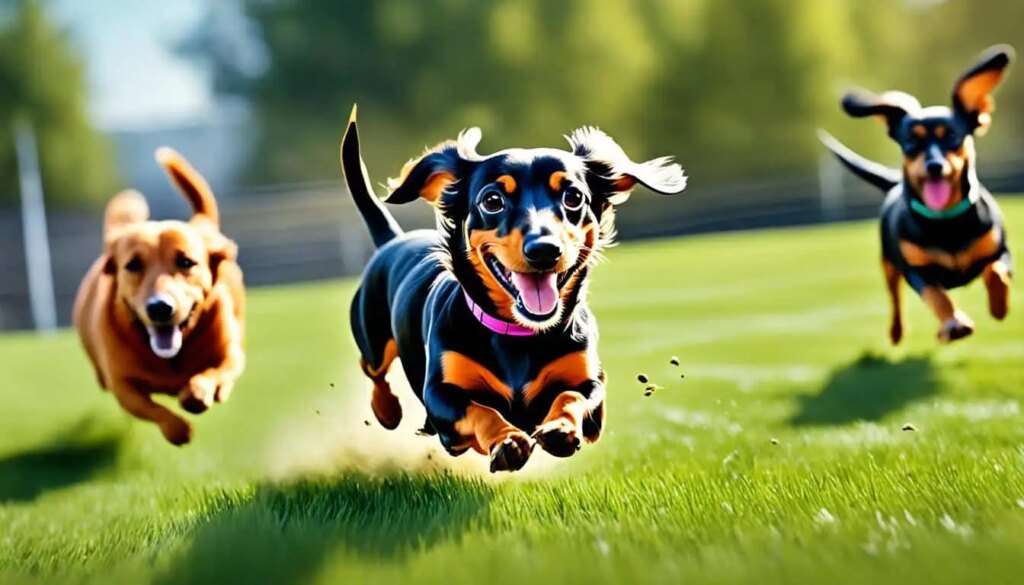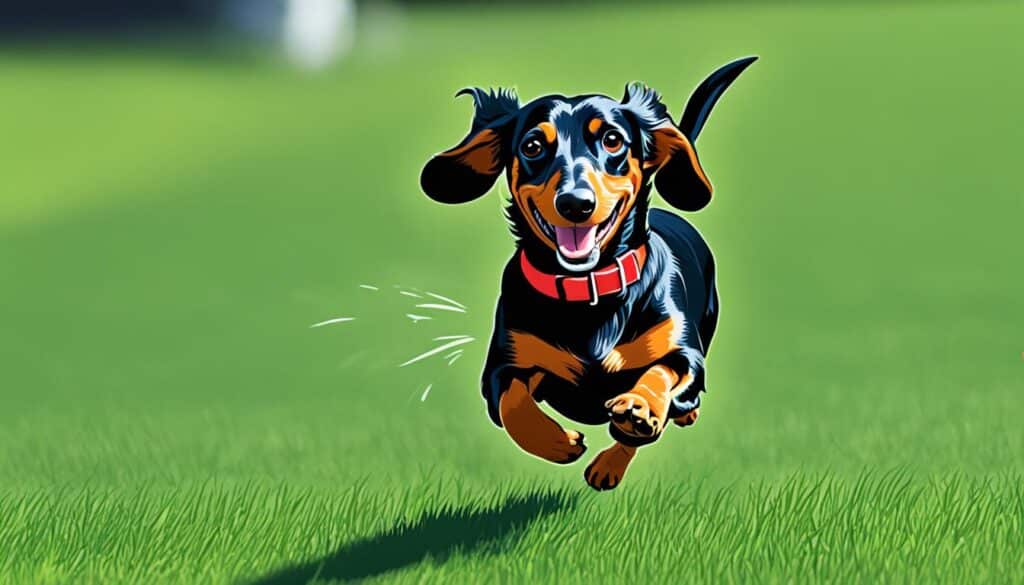Did you know that the behavior of Dachshunds can undergo a significant shift around the age of 1 year? This unexpected change in temperament and energy levels often leaves dog owners wondering when their beloved Dachshunds will finally mellow out. In this article, we will explore the fascinating world of Dachshund behavior and delve into the factors that contribute to their mellowing process.
Key Takeaways:
- Dachshunds typically experience a shift in behavior around the age of 1 year.
- Puppies are high-energy and require proper training.
- Young adult Dachshunds become more independent, requiring patience from their owners.
- Dachshunds generally become calmer after reaching 2 years of age.
- Each Dachshund matures at their own pace, so there may be individual differences in behavior.
Understanding the Dachshund’s Energetic Nature
Dachshunds are known for their lively and energetic nature. From their playful demeanor to their boundless energy, these dogs can truly light up a room. In this section, we will explore the various aspects of a Dachshund’s energetic nature, including their hunter instinct, the importance of exercise, and how age impacts their energy levels.
The Hunter’s Instinct: From Pursuit to Play
One of the key traits of Dachshunds is their strong hunter instinct. This instinct can be traced back to their origins as hunting dogs. Dachshunds were bred to hunt small game, such as badgers and rabbits, using their keen sense of smell and impressive agility. While they may no longer be used for hunting, their instinct to pursue and chase remains deeply ingrained.

This image showcases the energetic and active nature of Dachshunds, capturing their playful side and their love for exploration and adventure.
Exercise as a Mellowing Mechanism for Your Dachshund
To keep a Dachshund happy and well-balanced, regular exercise is essential. These dogs have high energy levels that need to be adequately channeled. Exercise not only helps to burn off excess energy but also provides mental stimulation, keeping them engaged and content. A tired Dachshund is a calmer Dachshund.
Engaging in activities such as daily walks, interactive play sessions, and even organized sports like agility training can help satisfy their need for physical exertion. It’s important to tailor the exercise routine to the individual dog, taking into account their age, health, and fitness levels.
The Impact of Age on a Dachshund’s Energy Levels
As Dachshunds age, their energy levels may naturally decrease. Puppies are famously known for their boundless energy and enthusiasm, often requiring more exercise and training to help them channel their energy in positive ways. Young adult Dachshunds may exhibit more independence and may require extra patience and guidance as they navigate their energetic phase.
Generally, Dachshunds tend to become calmer as they mature into adults, typically around 2 years old. However, it’s important to note that every Dachshund matures differently, so individual differences should be taken into consideration. Some Dachshunds may have higher energy levels even as adults, while others may become more mellow at an earlier age.
In conclusion, understanding the energetic nature of Dachshunds is crucial for providing them with the right amount of exercise, mental stimulation, and guidance. By embracing their hunter instinct, engaging in regular exercise, and recognizing the impact of age on their energy levels, you can help your Dachshund lead a happy and balanced life.
At what age do Dachshunds typically mellow out?
When it comes to Dachshunds, understanding their behavior and age-related changes can help you create a harmonious environment for your furry companion. While each dog is unique, there are general patterns that can give you an idea of when Dachshunds tend to mellow out.
1. Age Matters: Around the age of 1 year, you can expect a shift in your Dachshund’s behavior as they start to mature. During their puppy stage, they are full of energy and require proper training to channel that enthusiasm effectively.
2. Puppies: Dachshund puppies are known for their high energy levels and can be quite mischievous. It’s important to provide them with plenty of exercise, mental stimulation, and consistent training to help them develop good behavior habits.
3. Young Adults: As Dachshunds enter their young adult stage, typically around 1 to 2 years old, they may start to exhibit more independence. This phase requires patience and continued training to guide them through their newfound maturity.
4. Adults: Generally, Dachshunds become calmer and more settled after the age of 2 years. Their energy levels tend to stabilize, and they often become more affectionate and adaptable to their surroundings.
5. Individual Differences: It’s important to note that every Dachshund matures at their own pace. Some may mellow out earlier or later than average. Factors such as genetics, socialization, and prior training experiences can influence their development.
Proper training plays a crucial role in accelerating the mellowing process of Dachshunds. By providing a loving and stimulating environment combined with consistent training techniques, you can help your Dachshund become a well-adjusted and calm companion.
Training Techniques to Encourage a Calm Dachshund
Proper training can play a crucial role in encouraging a calm demeanor in your Dachshund. By employing effective training techniques, you can establish a strong bond with your furry friend while fostering positive behaviors. In this section, we will explore various strategies that can help you train your Dachshund to be calm and well-behaved.
The Role of Positive Reinforcement in Dog Training
Positive reinforcement is a powerful training technique that rewards desired behaviors and encourages their repetition. By utilizing this approach with your Dachshund, you can effectively reinforce calm and desirable behaviors. Whenever your Dachshund displays calmness, whether during meal times, interactions with other pets, or in unfamiliar situations, provide verbal praise, treats, or favorite toys as a form of positive reinforcement. This creates a positive association with calm behavior and motivates your Dachshund to continue exhibiting such behavior.
Managing Dachshund Aggression through Socialization and Commands
Socialization plays a significant role in managing Dachshund aggression. Early and ongoing exposure to different environments, people, and animals can help reduce aggressive tendencies. Gradually introduce your Dachshund to new experiences, ensuring positive interactions and rewarding calm behavior during these encounters. Additionally, teaching obedience commands such as “sit,” “stay,” and “leave it” can provide you with tools to redirect your Dachshund’s attention and prevent or manage potential aggressive situations.
Addressing Dachshund Separation Anxiety: Prevention and Solutions
Dachshunds are known for their affectionate nature, which can sometimes lead to separation anxiety when left alone. To address this issue, it’s important to gradually accustom your Dachshund to being alone. Start by leaving for short periods and gradually increasing the duration. Create a calming environment by providing interactive toys, treats, and a designated safe space where your Dachshund can relax. Additionally, consider using calming aids such as Adaptil diffusers or soothing music to promote relaxation in your absence.

| Age | Behavioral Characteristics |
|---|---|
| Puppies |
|
| Young Adults |
|
| Adults |
|
Each Dachshund matures at their own pace, so it’s essential to consider individual differences when training for calm behavior. While some Dachshunds may exhibit calmness earlier, others may take longer to reach a consistently calm state. Therefore, patience, consistency, and understanding are key when implementing training techniques.
By employing positive reinforcement, managing aggression through socialization and commands, and addressing separation anxiety, you can effectively train your Dachshund to be calm and well-behaved. Remember, proper training techniques and a loving, stimulating environment can contribute to a well-adjusted companion that brings joy to your family.
Conclusion
Understanding Dachshund behavior is essential for a harmonious relationship with these lovable furry friends. Throughout this article, we have explored the factors that contribute to their mellowing process, including age, training, and temperament.
Age plays a significant role in a Dachshund’s behavior. Around the one-year mark, you can expect a shift as puppies begin to mature. Puppies, characterized by their high energy levels, require proper training to channel their exuberance effectively.
As Dachshunds transition into young adults, they exhibit more independence, requiring patience and guidance from their owners. However, with time, they generally become calmer after reaching two years of age.
It is important to note that each Dachshund matures at its own pace, and individual differences in behavior should be expected. However, the impact of training on their mellowing process cannot be overstated. Proper training techniques, such as positive reinforcement, can accelerate the development of a calm and well-behaved Dachshund.
To provide a loving and stimulating environment for your Dachshund, ensure they receive the necessary training and socialization. By investing time and effort into their upbringing, you can have a well-adjusted companion that brings joy to your life.
